From Manger to Majesty – The Evolution of the Christmas Nativity Scene
When you think of Christmas, one of the most iconic symbols that comes to mind is the Nativity Scene. Also called a manger scene, this timeless depiction of the birth of Jesus has been a cherished part of Christmas for centuries. But have you ever wondered about the history behind the Nativity Scene?
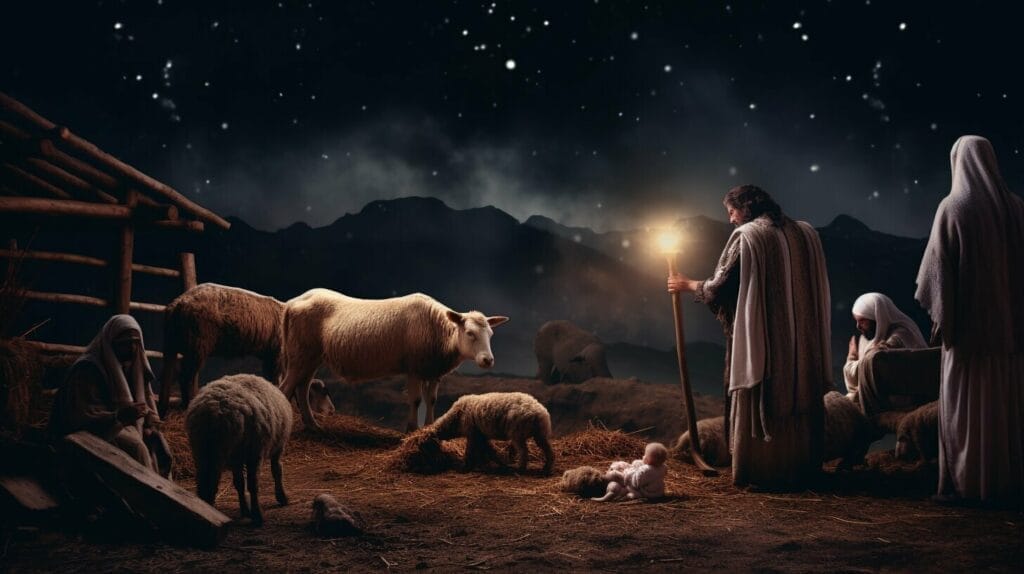
The story of the Christmas Nativity Scene begins with the birth of Baby Jesus in Bethlehem. According to the Bible, Jesus was born in a stable and laid in a manger, where he was visited by the Three Wise Men who followed the Star of Bethlehem. This momentous occasion has been celebrated for generations with the creation of Nativity Scenes, which have evolved over time to become an integral part of Christmas traditions worldwide.
In this article, we will explore the history and significance of the Christmas Nativity Scene. From the humble beginnings of the manger scene to the grand Christmas tableaus of today, we will take you on a journey through time to discover the majesty of this beloved symbol of Christmas.
Key Takeaways:
- The Christmas Nativity Scene has historical significance dating back to the birth of Jesus in Bethlehem.
- The Nativity Scene features the Baby Jesus, the manger scene, and the Three Wise Men guided by the Star of Bethlehem.
- The Nativity Scene has evolved over time to become an integral part of Christmas traditions worldwide.
- The Nativity Scene serves as a reminder of the Christian celebration of the birth of Jesus.
- The Nativity Scene offers enduring symbolism as a representation of the majesty of Christmas.
The Birth of Jesus and the First Nativity Scene
As you delve into the details of the birth of Jesus, you soon realize the inspiration behind the first Nativity Scene. The story of the Virgin Mary and Joseph is a timeless tale of love and faith.
According to the Bible, Mary was visited by an angel who told her she would conceive a child through the Holy Spirit. Joseph, her husband, learned of her pregnancy and was initially troubled but then visited by an angel who told him of God’s plan. Together, they traveled to Bethlehem, the birthplace of Jesus.
The visit of the shepherds and the appearance of angels are also significant elements of the Nativity Scene. The shepherds were the first to hear the news of Jesus’ birth from a group of angels who appeared in the sky. They traveled to Bethlehem to see the baby and spread the good news of his arrival. The angels, too, are important figures in the Nativity Scene, representing God’s message of hope and peace.
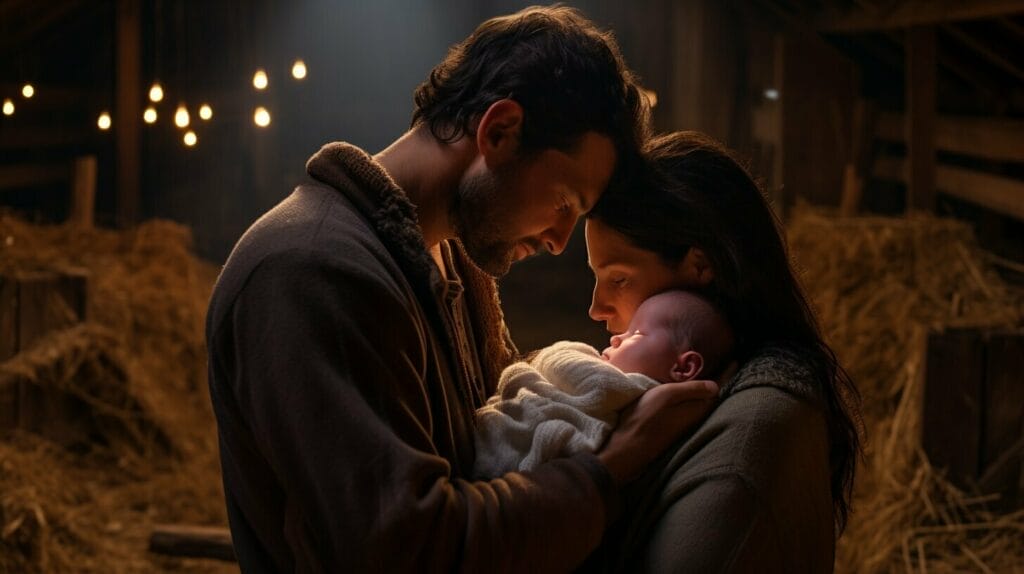
The Nativity Scene became a popular element of Christmas creche displays and Nativity plays. These traditions are still celebrated today, with people all over the world reenacting the birth of Jesus during the Christmas season.
Whether you are a part of a Nativity play or simply setting up a Christmas creche in your home, the Nativity Scene is a timeless reminder of the love and hope brought into the world by the birth of Jesus.
The Significance of the Three Wise Men
The Three Wise Men, sometimes called the three kings or Magi, are an iconic part of the Christmas Nativity Scene. Their inclusion represents an important aspect of the Christian celebration of the birth of Jesus. According to the Gospel of Matthew, the Magi followed the Star of Bethlehem to find the newborn king and bring him gifts of Frankincense, Myrrh, and Gold.
The journey of the Three Wise Men is a significant part of the Nativity history and is often portrayed in Christmas traditions and displays. This journey represents the universal Gospel message that Christ’s birth was for all people, not just for the Jews.
The symbolism of the gifts they brought is also rich with meaning. Frankincense was used in worship, representing Christ’s divinity. Myrrh was used for embalming, foreshadowing his death. Gold was a gift for a king, representing his royal status.
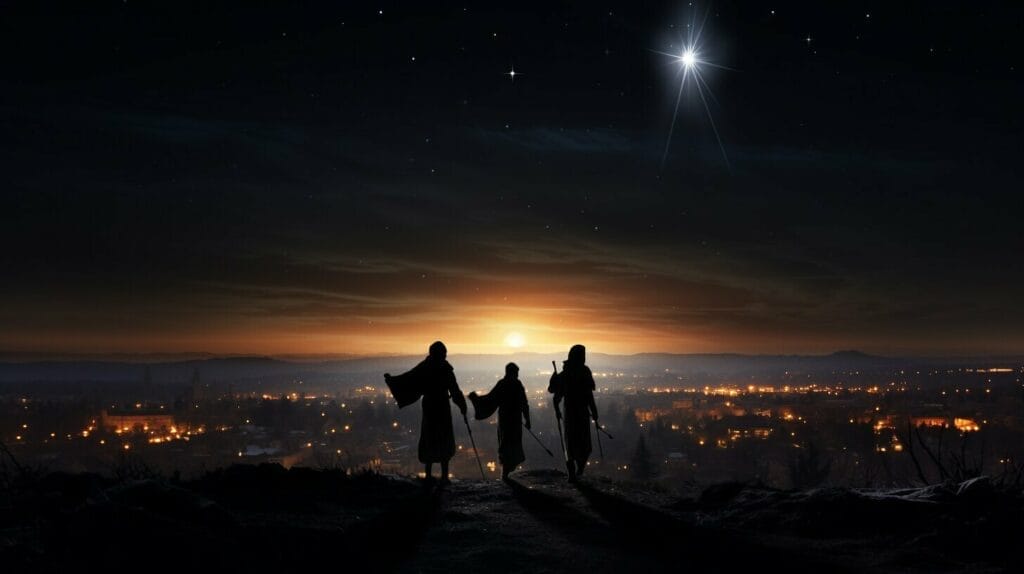
Over the years, the Three Wise Men have become an essential part of the Christmas tradition. Their inclusion in Nativity plays and displays, as well as their portrayal in art and literature, adds an element of wonder and majesty to the birth of Jesus. Whether you choose to display a simple Nativity Scene or a more elaborate one, the Three Wise Men will always be a cherished part of your Christmas celebration.
“And when they were come into the house, they saw the young child with Mary his mother, and fell down, and worshipped him: and when they had opened their treasures, they presented unto him gifts; gold, and frankincense, and myrrh.” – Matthew 2:11
The Setting: Bethlehem and the Christmas Stable
One of the most iconic elements of the Christmas Nativity Scene is the setting in which it takes place. The story of Baby Jesus’s birth is set in the small town of Bethlehem, which has become synonymous with the Nativity Scene.
The focal point of the Nativity Scene is the Christmas stable, where Jesus is born and laid in a manger. The stable is often depicted with straw or hay bedding, and surrounded by various Nativity figures such as Mary, Joseph, and the Three Wise Men.
Another important aspect of the Nativity Scene is the inclusion of Nativity animals. The presence of animals such as the ox and donkey in the stable serves to emphasize the humble and rustic nature of Jesus’s birth.
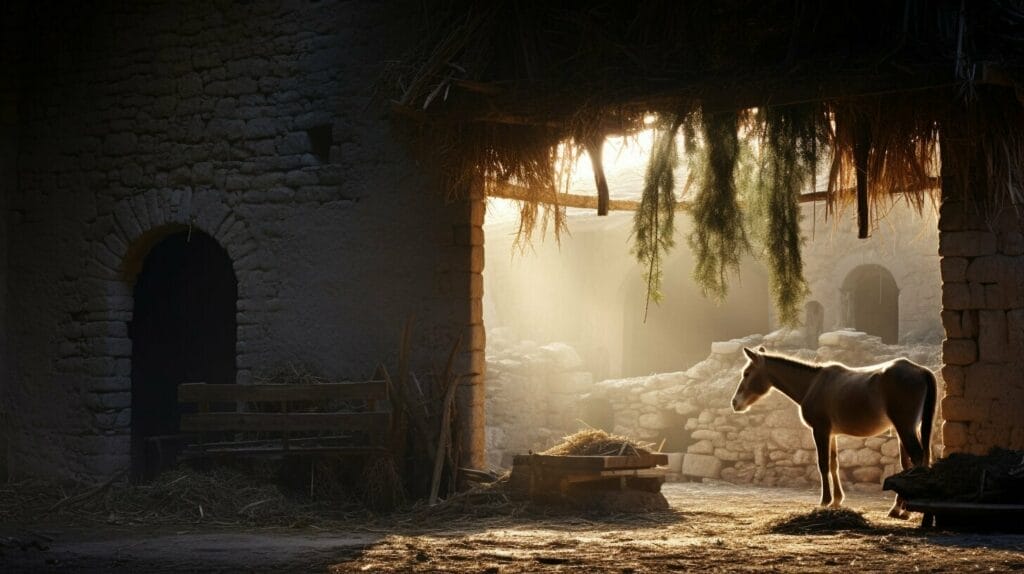
The Nativity figures and animals are often positioned around the manger, creating a complete scene of the birth of Jesus. This scene serves as a reminder of the humble surroundings of Jesus’s birth and the significance of the event.
The Nativity Scene has evolved over time, but the Christmas stable, Nativity figures, and animals remain a vital part of its depiction. As you reflect on the Nativity history and the Christmas traditions associated with it, take a moment to appreciate the symbolism of the setting and its importance in telling the story of the birth of Jesus.
The Gospel Accounts: Luke and Matthew
The birth of Jesus and the story of the Nativity Scene have their roots in the Gospels of Luke and Matthew. These Gospel accounts offer unique perspectives on the events leading up to and following the birth of Jesus.
In the Gospel of Luke, we read of the angel Gabriel visiting Mary to inform her that she will give birth to a son who will be called the Son of God. Mary and her betrothed, Joseph, travel from Nazareth to Bethlehem to register for the census, where they find no room at the inn and are placed in a manger. The shepherds are visited by angels, who tell them of the birth of Jesus and they go to find him, worshipping him and spreading the news of his birth. (Gospel of Luke 1:26-38, 2:1-20)
In the Gospel of Matthew, we read that Joseph, upon discovering Mary’s pregnancy, is visited by an angel in a dream who tells him not to be afraid to take Mary as his wife and that the child conceived in her is from the Holy Spirit.
The Magi, or the Three Wise Men, visit King Herod in search of the newborn king of the Jews. Herod learns of the child’s birth and orders the massacre of all male infants in Bethlehem, leading Joseph and Mary to flee to Egypt with Jesus. (Gospel of Matthew 1:18-25, 2:1-23)
The Gospel accounts provide the foundation for the Nativity Scene, with figures such as Joseph, Mary, the shepherds, and the Three Wise Men becoming central elements of the scene. Understanding the historical context of the Nativity Scene and the Gospel accounts deepens our appreciation for the enduring symbolism of this beloved Christmas tradition.

Imagine the humble circumstances of the birth of Jesus in a stable in Bethlehem. This beautiful and meaningful event inspired the creation of the first Nativity Scene. The Nativity Scene typically includes figures of the Holy Family, the Three Wise Men, shepherds, and animals, all gathered around the newborn baby Jesus in a manger.
The Nativity Scene has become an integral part of Christmas celebrations around the world, often incorporated into Nativity plays, Advent calendars, and Christmas tableaus. Nativity plays are a beloved tradition in which children reenact the story of the Nativity, complete with costumes and props.
Advent calendars often include a piece of the Nativity Scene to add to each day’s display leading up to Christmas. Meanwhile, Christmas tableaus and displays can range from simple and elegant to elaborate and grandiose, always highlighting the beauty and joy of the Nativity Scene.
One of the most important elements of the Nativity Scene is the Holy Family: Mary, Joseph, and the newborn Jesus. This representation reminds us of the love and devotion of the parents of Jesus and the importance of family in our lives.
Adding to the significance of the Nativity Scene are the Three Wise Men, who followed the Star of Bethlehem to bring gifts of Frankincense, Myrrh, and Gold to the newborn king. Their presence symbolizes the universality of Christ’s message and the power of faith.
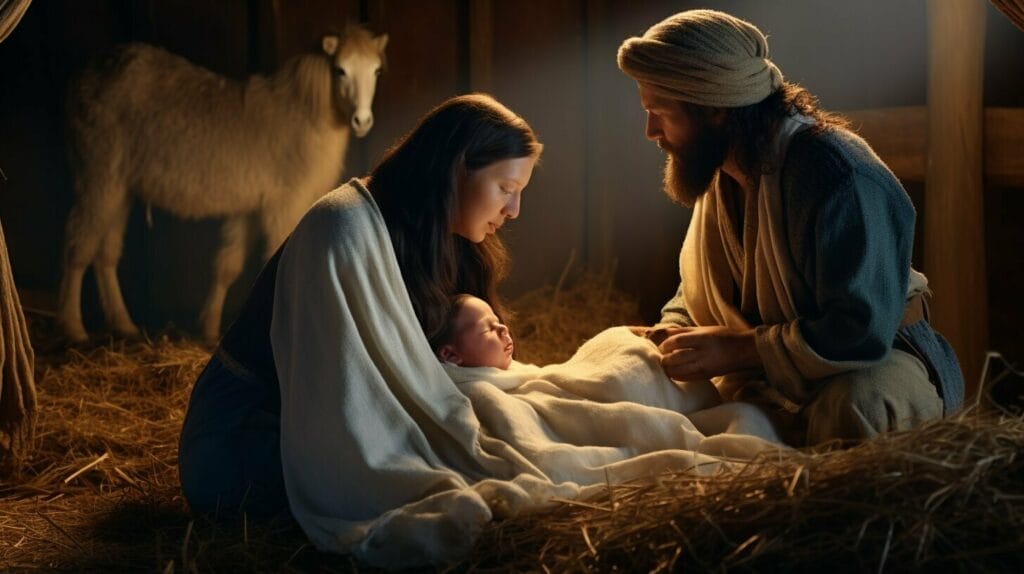
The Nativity Scene is a powerful and enduring symbol of the true meaning of Christmas. It reminds us of the sacredness of the holiday, and the importance of faith, family, and love. Whether we enjoy a simple Nativity display in our homes or participate in an elaborate Nativity play, the Nativity Scene continues to touch our hearts and inspire us every year.
The Enduring Symbolism of the Nativity Scene
As you reflect on the historical significance of the Christmas Nativity Scene, it’s important to remember its enduring symbolism. This cherished representation of the Christian celebration of the birth of Jesus has played a vital role in shaping Christmas traditions and history.
Through its evolution from the first Nativity Scene to the modern-day Nativity display, its power to inspire and educate has not diminished. The Nativity Scene serves as a reminder of the true meaning of Christmas – the birth of Jesus.
As you gather with loved ones during the holiday season and view a Nativity Scene, take a moment to reflect on its rich Nativity history and the role it continues to play in the celebration of Christmas traditions. Whether it’s through a Nativity play or a Christmas tableau, the Nativity Scene remains a beloved symbol of this festive season.
FAQ
Q: What is the history of the Christmas Nativity Scene?
A: The Christmas Nativity Scene has its origins in the birth of Jesus. It is a representation of the manger scene in Bethlehem, where Baby Jesus was born. The Nativity Scene gained popularity over time and has become an important symbol of the Christmas holiday.
Q: How did the first Nativity Scene come about?
A: The first Nativity Scene was inspired by the birth of Jesus. It included figures such as Virgin Mary, Joseph, shepherds, and angels. This scene became a popular element of Christmas creche displays and Nativity plays.
Q: Who are the Three Wise Men and why are they significant?
A: The Three Wise Men were biblical figures who journeyed to Bethlehem guided by the Star of Bethlehem. They brought symbolic gifts of Frankincense, Myrrh, and Gold to Baby Jesus. Their inclusion in the Nativity Scene has become a cherished Christmas tradition.
Q: What is the significance of the setting in the Nativity Scene?
A: The setting of the Nativity Scene is Bethlehem, the birthplace of Jesus. The Christmas stable, where Baby Jesus was laid in a manger, became a focal point of the scene. Nativity figures and animals, such as the ox and donkey, are often included to enhance the depiction.
Q: What do the Gospel accounts of Luke and Matthew say about the Nativity?
A: The Gospel of Luke and the Gospel of Matthew provide different perspectives on the birth of Jesus. They describe the role of Mary and Joseph, the visit of the shepherds, and the presence of King Herod. These accounts help us better understand the Nativity Scene.
Q: How is the Nativity Scene brought to life during the Christmas season?
A: The Nativity Scene is brought to life in various ways. Nativity plays and Christmas tableaus are performed to tell the story. Advent calendars and elaborate Nativity displays are also popular ways to celebrate the birth of Jesus. The Holy Family, consisting of Mary, Joseph, and Baby Jesus, holds a central role in these representations.
Q: What is the enduring symbolism of the Nativity Scene?
A: The Nativity Scene holds great symbolism in the Christian celebration of the birth of Jesus. It reminds us of the humble beginnings of Jesus and the importance of his coming into the world. The Nativity Scene has played a significant role in shaping Christmas traditions and history.




